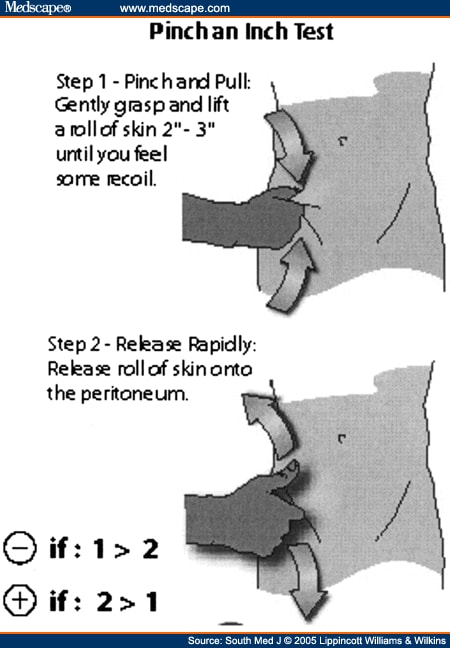Abstract and Introduction
Rebound tenderness is a widely used examination technique for patients with suspected appendicitis, but it can be quite uncomfortable. An alternative test for peritonitis is termed the pinch-an-inch test. This report describes two patients who presented with mild abdominal pain who subsequently were found to have appendicitis. In both patients, classic peritoneal signs were absent, but the pinch-an-inch test was positive. The experienced physician's bedside clinical examination remains the most critical component for rapidly identifying peritonitis. Although rebound tenderness is a widely used examination, it is uncomfortable and may be inaccurate. To perform the pinch-an-inch test, a fold of abdominal skin over McBurney's point is grasped and elevated away from the peritoneum. The skin is allowed to recoil back briskly against the peritoneum. If the patient has increased pain when the skin fold strikes the peritoneum, the test is positive and peritonitis probably is present.
Rebound tenderness, a widely used physical examination test for patients with suspected appendicitis, can be quite uncomfortable for the patient.[1,2] Accordingly, some standard references no longer advise its use on patients with abdominal pain.[3,4] We recently developed an alternative test for peritonitis that in our experience produces less discomfort for patients. We colloquially termed this peritoneal sign the pinch-an-inch test. To the best of our knowledge, others have not described it.
Our pinch-an-inch test is essentially a form of rebound tenderness, only in reverse. To perform the test, a fold of abdominal skin over McBurney's point is grasped and elevated away from the peritoneum (see Fig. 1). The skin is then allowed to recoil back briskly against the peritoneum. If the patient has increased pain when the skin fold strikes the peritoneum, the test is positive and peritonitis is presumably present. As an added feature, if the pain seems excessive just during the initial pinch phase, the patient may have a very low pain threshold, a factor that can be taken into account when deciding if the patient has a surgical abdomen. We anecdotally have found the test to be remarkably helpful for the evaluation of appendicitis as exemplified by the following cases.
Source: http://www.medscape.com/viewarticle/521231

No comments:
Post a Comment